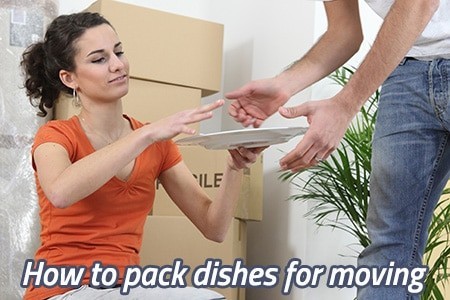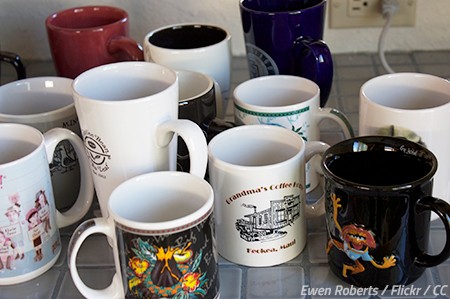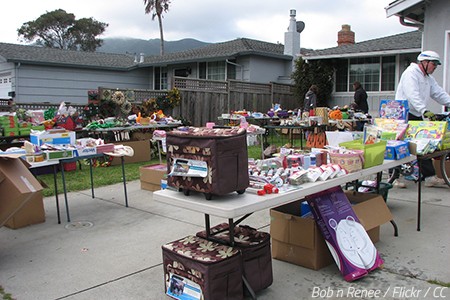If you’re interested in learning how to pack dishes for moving, then you must have already started the arduous task of packing a house for a move.
It is no secret that packing is the ultimate challenge when moving house – the most time-consuming task that is notorious for having the potential to spoil even the most impeccable plans.
And if you’ve read some of our other packing tips, you will definitely be familiar with the number 1 rule when packing for a move: Start packing your stuff as soon as you can, and never look back.
Together with storage areas, kitchens are the next toughest premises to sort and pack into suitable moving boxes.
So, what is the best way to pack dishes for moving?
Read on to find out the answer.
What you need to pack kitchen plates for moving
Packing dishes for moving can be rather tricky due to the extra-fragile nature of kitchen plates. Plates are commonly made from ceramic materials such as bone china, porcelain, and glazed earthenware, and that fact alone makes them extremely susceptible to damage during a move. And this is exactly why you should make sure you’re using the proper dish packing supplies in order to avoid finding any pieces of broken kitchenware upon arrival in your new home.
Reinforced cardboard boxes. It’s best if you play it safe and bet on special boxes made of double layers of corrugated cardboard to better protect their highly fragile content. Also known as dish boxes (or sometimes even dish packs), these specialized containers with thicker walls are ideal for serving your immediate agenda – packing dishes safely so that they don’t break during transport. However, if you haven’t secured any dish boxes before packing your fragile kitchen plates, then don’t worry – ordinary cardboard boxes will also do provided that you follow the padding steps described below.
Let the dish packing challenge begins!
Bubble wrap. Okay, one thing is clear – you’re going to need a lot of bubble wrap simply because the famous bubbly protective material is your best friend when it comes to packing plates in moving boxes for dishes. The simple truth is that if you can afford enough bubble wrap, the chances are you won’t get to even see a single crack on your kitchen breakables.
Packing paper. The best dish wrapping paper is soft, white, acid-free packing paper that you can purchase online or from any home improvement store. The greatest advantage of wrapping kitchen plates with wrapping paper is that it creates a soft protective layer as the first line of protection for your fragile dishes.
A word of warning: Don’t use newsprint (newspapers) directly onto the delicate surfaces of kitchen plates. be aware of is that newsprint can easily leave ink stains on your valuable kitchen plates. Those ink marks are not only hard to remove, but they could also completely ruin a kitchenware piece, and consequently – a set.
Packing tape. You’re going to need a roll of high-quality packing tape to be able to secure the paper and bubble wrap once you bundle the porcelain plates. The tape will keep the dish packing supplies from getting unwrapped during transport.
A set of markers. Prepare a black marker and a red marker to label the packing boxes for dishes once they are full. Use the black marker to write down the content (KITCHEN PLATES) and destination room (KITCHEN), then mark down FRAGILE and HANDLE WITH CARE with the red marker pen to draw attention to the fragile nature of the load.
10 Delicate Tips for Packing Fragile Items When Moving
How to pack dishes for moving
Follow the detailed steps below to learn how to pack dishes safely regardless of the distance your breakables will travel – be it just a few miles across town or a few thousand miles across the country.
Here, we will describe the individual dish packing method that’s known to offer the best level of protection for your breakable kitchen items. At first, that packing technique may feel a bit slow but once you get the knack of it after wrapping up a few kitchen plates, you’ll be able to speed it up thanks to its repetitive nature. In fact, you shouldn’t have any problems packing up your dishes for a move as long as you observe a few fundamental safety rules and guidelines.
So, how to pack plates for moving? Follow these packing steps and you should ace the task of packing your fragile items in no time.
Step 1: REINFORCE the bottom of each box you’re about to use for packing your dishes for moving. How? Tape the central bottom line of the box from the outside even if the cardboard container is brand new. Also, strengthen the sides of the containers just to stay on the safe side and avoid any heartbreaking instances of a box breaking under the weight of the packed china plates.
Step 2: PAD the insides of the moving boxes with crumpled packing paper or newspapers. The idea here is to create a soft insulation layer that will absorb any shocks during the relocation journey, thus keeping the packed kitchen plates as safe as they can be. Skipping this preparation step could seriously endanger the safety of the entire packing operation. In addition to paper, you can also use sheets of bubble wrap or even bath towels to pad the bottom of each dish packing box.
Step 3: DESIGNATE a packing station – the place where you’ll do the actual job of wrapping your kitchen plates in paper and bubble wrap before transferring them into suitable boxes. You’re recommended to use the kitchen table for that purpose. Packing dishes on the floor is also an option but you’ll need to bend over constantly which will place extra strain on your back and legs.
Step 4: PLACE the stack of soft packing paper onto the kitchen table. Remember that you don’t want to use newspapers due to the potential risk of newsprint ink transferring onto the delicate surface of your valuable kitchen items. A roll of acid-free and ink-free packing paper (500 sheets) costs around $25 and should be more than enough to protect all the china plates you have in your kitchen.
Step 5: POSITION a fragile kitchen piece onto the center of the stack and cover it by pulling a few sheets over the breakable plate. Working diagonally from one corner onto the next one, wrap the piece completely by tucking in the paper ends in the very center of the plate. Then, use a bit of tape to secure the paper bundle.
Follow the dish packing steps in this moving guide to keep your kitchen breakables safe and sound during a house move.
Step 6: KEEP packing up your kitchen plates, one by one, using the simple dish wrapping technique described in Step 5. Once you’re done wrapping several plates in paper, you’ll be able to speed up the packing process thanks to its repetitive nature.
Step 7: CONSIDER adding an extra layer of bubble wrap for your more expensive and valuable sets of kitchen plates. A single additional sheet of bubble wrap over the paper bundle will guarantee the safety of those extra-fragile objects. Again, use a bit of tape to secure that top bubble-wrap layer.
Step 8. TRANSFER the wrapped-up plates into the dish boxes, one by one. The proper technique for arranging your kitchen breakables is to lay them inside the moving containers standing on their edges, and never flat. Another dish packing tip to keep in mind is that heavier plates should always go to the box bottom while the lighter fragile kitchenware should go on top of them.
Step 9: SEPARATE each arranged row of kitchen plates from the next one with the help of adequate insulators – paper, bubble wrap, towels, or any other piece of clothing for that matter. This way, you’ll be adding yet another level of protection for the kitchenware pieces.
Step 10: FILL in any remaining gaps inside the fish packing boxes to immobilize the entire package. Do it by adding pieces of paper, discarded sheets of bubble wrap, or pieces of old clothing. Your goal is to ensure that no kitchenware piece can shift inside the container during the relocation trip.
Step 11: TEST whether you’ve managed to immobilize the kitchen plates packed inside each box by lifting the container off the ground and shaking it ever so slightly in the air. Ideally, you shouldn’t feel anything moving inside the dish box. If you do, then add more paper or bubble wrap to fill any remaining gaps.
Step 12: PLACE one final protective layer of paper or bubble wrap on the very top, then close the lid and seal it shut using packing tape.
Step 13: LABEL each packed dish box. This is the final step of packing dishes when moving that most people tend to overlook. But you shouldn’t underestimate the importance of the box labeling task: simply take a black marker pen and write KITCHEN PLATES on at least 2 sides of each container. Also, add HANDLE WITH CARE, and FRAGILE using a red marker to draw attention to the fragile nature of the content of each dish pack.
How to Pack Glasses for Moving: Glassware Packing Guide
Safety tips for packing dishes
It would be disastrous to find some of your favorite sets of kitchen plates ruined after opening the moving boxes to start the unpacking process. To avoid such an unpleasant occurrence from ever happening to you, here are a number of additional safety tips for packing plates when moving house:
To save valuable time and money at the same time, inspect all of the china plates you’re about to pack away and see if there are pieces that are just not worth the effort. For example, it won’t make much sense to pay for the transportation of rather inexpensive sets of kitchenware that are already cracked, chipped, or ruined in some way. Remember that each added pound to the overall weight of your shipment will increase, be it by little, the final moving cost.
Can you ensure the safety of your priceless collection of hand-painted plates?
You are definitely not advised to make a dish box too heavy unless you’re eager to experience a moving day accident on a smaller scale. Keep the boxes filled in with fragile kitchen plates below 40 lbs. to keep your residential move accident-free.
If you end up being the person to carry the dish boxes to the moving vehicle and maybe even loading the fragile kitchen items into the truck itself, you need to be extremely careful when handling the cardboard boxes to avoid untimely trouble.
Packing breakable dishes is anything but a joke. If you feel like this tough task is more than you can handle, or if you’re desperately running short on time, then don’t hesitate to get in touch with experienced packers to give you the professional touch you need.
Can you think of other valuable pieces of advice on how to pack plates for moving? Please leave your comments below.
The post How to Pack Dishes for Moving: Dish Packing Guide appeared first on The Moving Blog.







